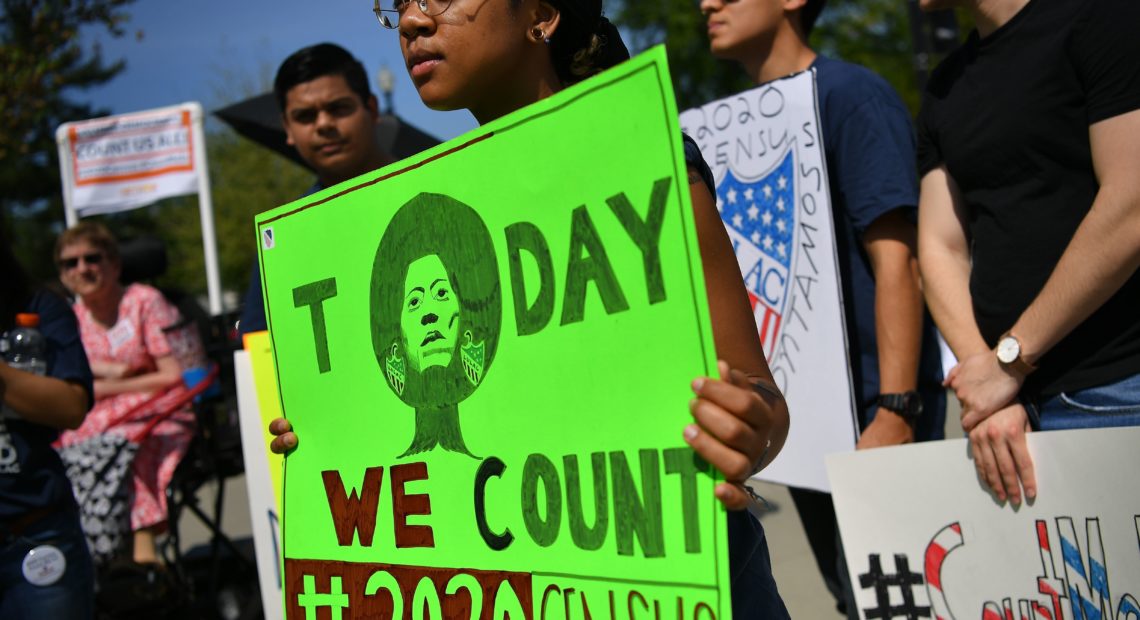
Judge To Review Claims Of Census Citizenship Question’s ‘Discriminatory’ Origins
PHOTO: Demonstrators against a proposal to add a citizenship question to the 2020 census protest outside the U.S. Supreme Court in Washington, D.C., in April. CREDIT: Mandel Ngan/AFP/Getty Images
BY HANSI LO WANG AND BOBBY ALLYN
A federal judge in Maryland is moving forward with a case that claims the Trump administration intended to discriminate against immigrant communities of color by adding a citizenship question to the 2020 census.
U.S. District Judge George Hazel ordered proceedings to continue after lawyers with the Justice Department confirmed in a court filing Friday that they are still exploring possible ways to add the question — “Is this person a citizen of the United States?” — to the census form. On Wednesday, President Trump indicated that he wants to find a way to do that would be acceptable to the Supreme Court.
Last month, the Supreme Court voted to leave in place a lower court ruling that rejected the Trump administration’s stated reason for the question. In the majority opinion, Chief Justice John Roberts said that the administration’s use of the Voting Rights Act to justify the question “seems to have been contrived.”
Hazel’s order means that as the Trump administration prolongs the legal fight to add a citizenship question to the census, more evidence may be revealed in court about how and exactly why the administration tried to include it.
The president was asked why on Friday, as he departed the White House for a weekend at his New Jersey golf club. “You need it for Congress, for districting,” he told reporters. “You need it for appropriations.”
Census information helps guide how some $880 billion a year in federal spending is distributed for schools, roads and other public services. The constitutionally mandated head count of every person in the U.S. also determines how many congressional seats and Electoral College votes each state is allotted for a decade.
The population numbers used, however, represent the total number of residents, not just U.S. citizens.
The administration argued for evidence-gathering for the Maryland-based lawsuits to be put on hold while the administration continues searching for a new reason to add the question. But Hazel ordered an immediate start to discovery, the legal process during which both sides dig for information and conduct interviews. Court documents show that officials from the Justice and Commerce departments will have to sit for questioning under oath if the discovery process continues as planned.
“Plaintiffs’ remaining claims are based on the premise that the genesis of the citizenship question was steeped in discriminatory motive,” Hazel wrote in a letter explaining his order. “Regardless of the justification Defendants may now find for a ‘new’ decision, discovery related to the origins of the question will remain relevant.”
Trump administration officials have said the addition of the citizenship question is needed to better protect the voting rights of racial and language minorities. But plaintiffs argue that Trump officials are attempting to give a political advantage to Republicans and non-Hispanic white people when new voting districts are drawn.
Also on Friday, Trump said he is “very seriously” considering an executive order that would place a citizenship question on the 2020 census.
“We have four or five ways we can do it,” Trump told reporters. “We’re working on a lot of things, including an executive order.”
Opponents of adding the citizenship question to the census pointed out that an executive order cannot supersede a court ruling.
“Such an order does not override a Supreme Court or other judicial decision; nor does it overturn or circumvent the congressionally established process for determining the content of the census,” said Thomas Saenz, president and general counsel of the Mexican American Legal Defense and Educational Fund, which is representing some of the groups that sued the Trump administration over the question.
Meanwhile, the clock is ticking. Around 1.5 billion paper mailings for the 2020 census — including some 137 million questionnaires — have to be printed so they can hit mailboxes starting in mid-March. Officials at the Justice Department and the Commerce Department, which oversees the Census Bureau, said earlier this week that the printing of paper forms without the citizenship question has already started.
Trump suggested that officials could print the question as “an addendum,” but such an unusual move with the once-in-the-decade questionnaire is not described in the Census Bureau’s detailed operational plan for the 2020 census.
9(MDAyOTk4OTc0MDEyNzcxNDIzMTZjM2E3Zg004))















